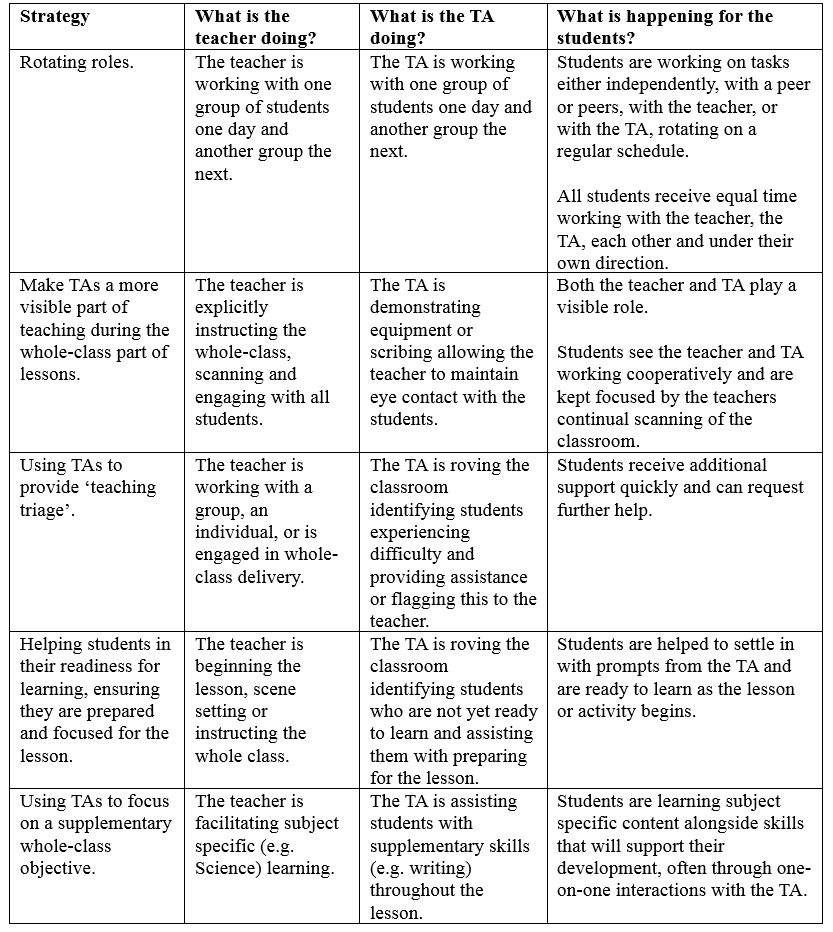Clarity around the role of a teaching assistant (TA) in Australia can be a challenge. The term ‘teaching assistant' refers to an adult who works in the classroom to support teachers. They are also commonly known as school learning support officers, teachers' aides, assistant teachers, classroom support officers or integration aides.
Across jurisdictions the terminology, role descriptions, qualifications and legislative requirements are varied. In a previous article on the effective use of TAs, Dr Tanya Vaughan explored the employment statistics and education level of TAs in Australia and the impact of TAs on students' learning. While we acknowledge the complexity of the field, this article looks to highlight a few concrete recommendations that schools can adopt and adapt in their own settings.
While there are exceptional TAs across the country, and pockets of excellence, some Australian studies have observed an unsupported and ill-prepared TA workforce (Butt, 2018). Even the most highly qualified TAs, applied ineffectively, will not have the impact on student achievement that they could have if they were thoughtfully utilised.
Teachers and school leaders can make small modifications, both structural and in teaching practice, enabling TAs to have a greater impact on students' outcomes.
What is the Guidance Report?
Drawing on learnings from the Education Endowment Foundation (EEF), Evidence for Learning (E4L) are developing a range of Guidance Reports, contextualised for Australian practitioners. The next to be released in September will explore the best use of TAs.
Global research has identified seven recommendations which guide the effective use of TAs in schools. One of the recommendations underpins the thoughtful use of teaching assistants – Use TAs to supplement what teachers do, not replace them.
An international review of the use of TAs in classrooms for the past 10 years, including studies based in Australia, identified that TAs were observed to replace the role of the teacher for students with disabilities (Sharma & Salend, 2016). This can result in students that require support receiving the least attention from their teacher – and in these scenarios, the achievement gap is seen to grow, reinforcing inequities (Evidence for Learning in collaboration with Melbourne Graduate School of Education, 2019). It is essential that teachers and teaching assistants work together to ensure that all students are receiving the support that they need (Education Endowment Foundation, 2019).
We've drawn some practical suggestions from E4L's Guidance Report Making best use of Teaching Assistants to help teachers and school leaders apply evidence-based practices to their schools and classrooms.
Strategies for supplementing a teacher in a classroom

Adapted from Sharples, Webster & Blatchford (2015).
Who is responsible for ensuring TAs are used effectively?
At the end of the day, this is a shared endeavour. It requires school leaders, administrators, teachers and teaching assistants to develop a shared understanding of the role and value of TAs. This Guidance Report is targeted at school leaders and teachers as the focus is to utilise teaching assistants effectively.
References
Butt, R. (2018). ‘Pulled in off the street' and available: what qualifications and training do Teacher Assistants really need? International Journal of Inclusive Education, 22(3), 217-234.
Education Endowment Foundation. (2019). Evidence for Learning Teaching & Learning Toolkit: Education Endowment Foundation. Teaching Assistants. Retrieved from https://evidenceforlearning.org.au/teaching-and-learning-toolkit/teaching-assistants/
Evidence for Learning in collaboration with Melbourne Graduate School of Education. (2019). Teaching assistants: Australasian Research Summary. Retrieved from https://evidenceforlearning.org.au/the-toolkits/the-teaching-and-learning-toolkit/australasian-research-summaries/teaching-assistants
Sharma, U., & Salend, S. J. (2016). Teaching assistants in inclusive classrooms: A systematic analysis of the international research. Australian Journal of Teacher Education, 41(8), 7.
Sharples, J., Webster, R., & Blatchford, P. (2015). Making Best Use of Teaching Assistants: Guidance Report. Retrieved from https://educationendowmentfoundation.org.uk/public/files/Publications/Teaching_Assistants/TA_Guidance_Report_MakingBestUseOfTeachingAssistants-Printable.pdf
As a school leader, are there structures in your school that support teachers and TAs to connect outside of class time?
As a teacher, how can you think about the structure of your classes to best draw on the support of the TA?
As a TA, how can you make yourself more visible while supporting the teacher?



